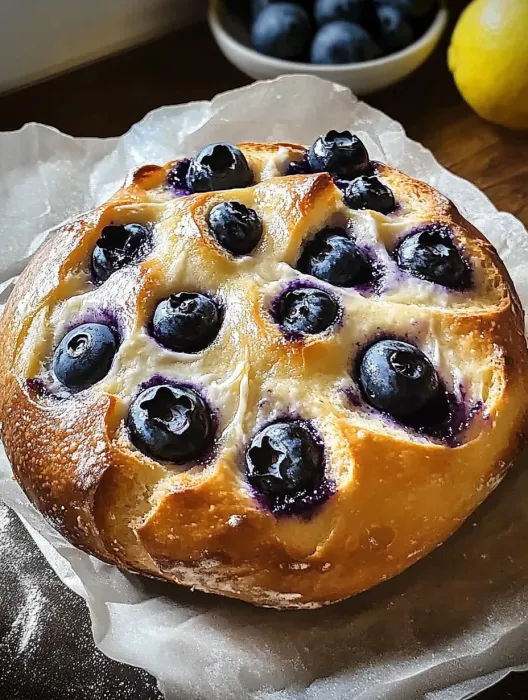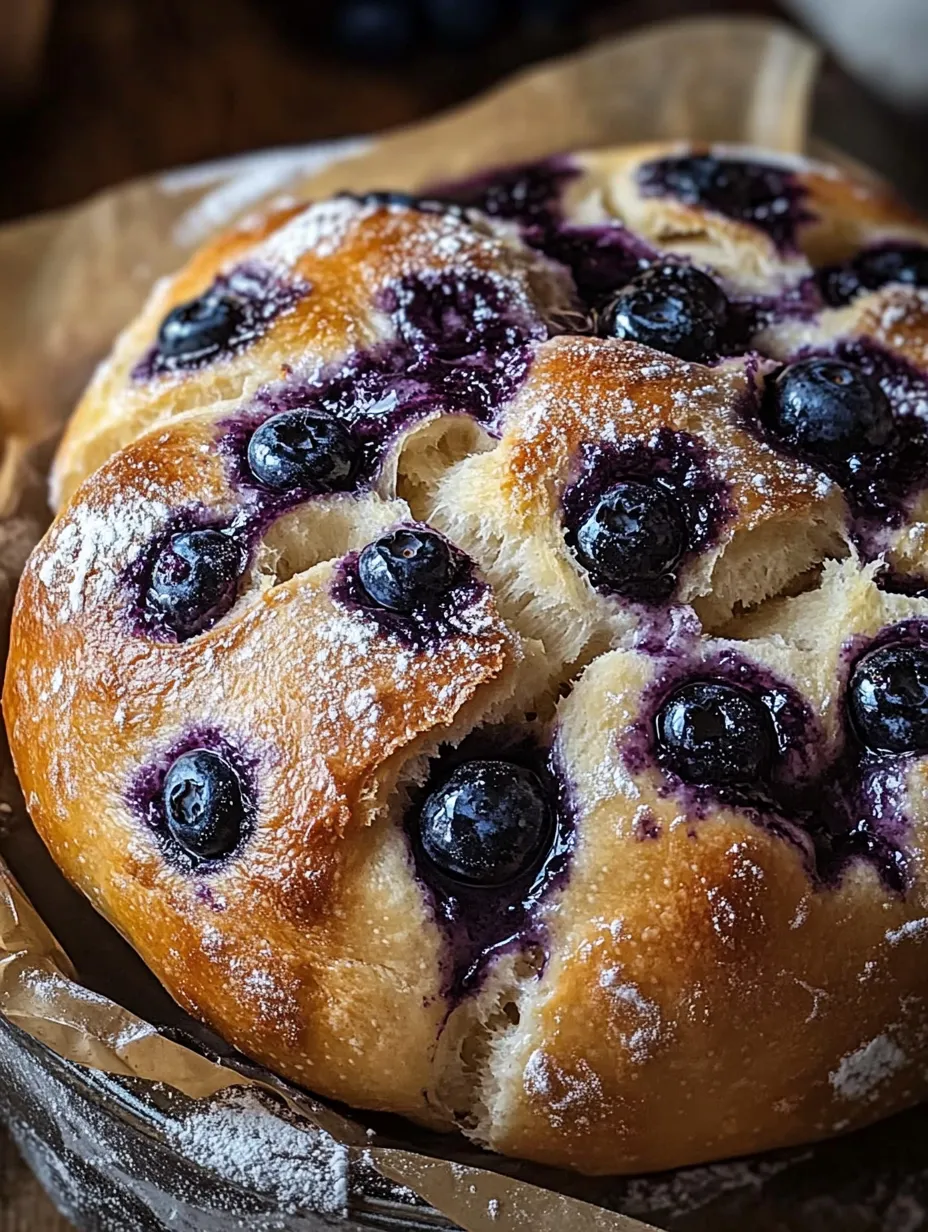 Save
Save
This lemon blueberry sourdough focaccia combines the tangy complexity of sourdough with sweet blueberries and bright lemon for a breakfast treat that straddles the line between bread and dessert. The crispy edges and soft interior create a delightful texture, while the muffin-style crumb topping adds a sweet crunch that makes this unlike any traditional focaccia.
I first developed this recipe during spring when my sourdough starter was particularly active and blueberries were just coming into season. What began as an experiment quickly became a family favorite that my kids request whenever company visits.
Ingredients
- Sourdough starter ripe and active providing the signature tangy flavor and natural leavening
- Bread flour with its higher protein content gives the perfect chewy yet tender structure
- Fresh blueberries are essential for both flavor bursts and preventing excess moisture that frozen berries would release
- Lemon zest brightens the entire recipe with concentrated citrus oils that infuse throughout
- Light olive oil creates that classic focaccia texture while butter adds richness
- Brown sugar in the crumb topping caramelizes slightly during baking for depth of flavor
Step-by-Step Instructions
- Build the Levain
- Combine 6g ripe starter with 60g water and 60g flour in a small container. Let ferment overnight at approximately 78°F until doubled in size with a bubbly surface and sweet aroma. This slow fermentation develops complex flavors that make this recipe special.
- Mix the Dough
- Combine your ripe levain with water, sugar, salt, lemon zest and bread flour. The mixture will seem quite wet at this stage which is correct for focaccia. Stir until no dry spots remain then cover and allow to rest for 30 minutes to initiate gluten development.
- Perform Coil Folds
- Instead of traditional kneading, this dough develops strength through a series of gentle coil folds. With wet hands, lift the center of the dough allowing it to stretch without tearing, then fold it under itself. Rotate the bowl and repeat. The first set will be very sticky but each subsequent fold will show noticeable improvement in dough strength.
- Incorporate Blueberries
- During the third set of folds, add most of the blueberries directly to the dough. Continue folding gently to distribute them throughout without crushing. This technique ensures berries are suspended throughout the dough rather than all sinking to the bottom.
- Bulk Fermentation
- Allow the dough to rise until increased by approximately 50% in volume. This longer rise develops flavor and creates the airy structure characteristic of good focaccia. The dough should look puffy with visible bubbles forming.
- Pan and Final Proof
- Transfer the dough to a generously oiled pan lined with parchment. The oil is crucial for the signature crispy bottom. Allow to proof until doubled and airy, which may take 2 to 3 hours depending on your environment.
- Add Toppings and Dimple
- Create the crumb topping by mixing butter, brown sugar, flour and salt until crumbly. Spread over the dough along with remaining fresh blueberries, then gently press fingertips into the dough creating the classic focaccia dimples that capture pockets of oil and butter.
- Bake and Glaze
- Bake in a hot oven until golden and crisp around the edges. While still warm, drizzle with tangy lemon glaze that will partially melt into the warm bread creating pockets of sweet citrus flavor that complement the berries perfectly.

My favorite part of this recipe is watching the transformation during baking. The blueberries burst and create beautiful purple swirls throughout the dough while the lemon zest perfumes the entire kitchen with a bright citrus aroma that signals something special is happening.
Storage and Serving
This focaccia is at its absolute best the day it's baked, when the contrast between crispy exterior and soft interior is most pronounced. Store any leftovers at room temperature in an airtight container for up to two days. For longer storage, slice and freeze individual portions to maintain texture.
To refresh day-old focaccia, warm in a 300°F oven for about 10 minutes. The heat will revive some of the crispness while maintaining the tender interior. Avoid microwaving which makes the texture gummy.
Seasonal Variations
While blueberries and lemon create a perfect spring combination, this focaccia base adapts beautifully to other seasonal fruits. In summer, try fresh raspberries with orange zest. Fall brings opportunities for sliced apples with cinnamon sugar topping. Winter versions work wonderfully with cranberries and orange for holiday gatherings.
The key to successful variations is maintaining the same moisture balance. Whatever fruit you choose should be similar in water content to fresh blueberries to avoid affecting the dough structure.
Troubleshooting Tips
If your dough seems too wet during mixing, resist adding much extra flour. This high hydration creates the open crumb structure. Instead, use wet hands during handling and trust the folding process to build strength.
For novice bakers, the finger poke test helps determine when final proofing is complete. Gently press a floured finger into the dough. It should slowly spring back but leave a slight indentation. If it springs back completely, it needs more time. If the indentation remains without movement, it may be overproofed.

Recipe FAQs
- → Can I use regular sourdough starter instead of making a levain?
Yes, you can substitute 120 grams of ripe, bubbly, active sourdough starter for the same amount of levain in this recipe. The levain method is recommended for more consistent results, but direct starter substitution works fine.
- → Can I use frozen blueberries instead of fresh?
Fresh blueberries are strongly recommended for this focaccia. Frozen blueberries will lower the dough temperature and release excess moisture, making the dough too wet and difficult to work with. Fresh berries maintain their shape better during folding and baking.
- → How long can I refrigerate the dough before baking?
After shaping the dough in the pan, you can refrigerate it for up to 48 hours before proceeding with the final proof and baking. This cold fermentation can enhance flavor development while accommodating your schedule.
- → What kind of olive oil works best for this sweet focaccia?
Choose a light-flavored olive oil rather than extra virgin olive oil, which can impart too strong an olive flavor to the sweet dough. Alternatively, you can substitute the olive oil with melted butter if you prefer no olive flavor at all.
- → Can I use all-purpose flour instead of bread flour?
This is a high-hydration dough, so bread flour (with at least 12.5% protein content) is recommended for structural strength. If using all-purpose flour, which has lower protein content, you should reduce the water in the recipe to prevent an overly sticky, difficult-to-manage dough.
- → How do I know when my focaccia is properly proofed?
Properly proofed focaccia dough will be doubled in size, puffed up, and very airy. It should look jiggly and be aerated with visible air bubbles. If the dough doesn't exhibit these characteristics, place it in a warmer environment and allow it to rise longer.
